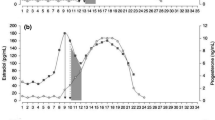Summary
Plasma catecholamine concentrations at rest and in response to maximal exercise on the cycle ergometer (278±15 watts, 6 min duration) have been measured on seven young active male subjects (19±1 years old; 80±3 kg; 176±3 cm) prior to and after a eight week leg strength training program (5RM, squat and leg press exercise). Strength training resulted in a significant increase in performance on squat (103±3 to 140±5 kg) and leg press exercise (180±9 to 247±15 kg) associated with a small significant increase in lean body mass (64.5±2.2 to 66.3±2.1 kg) and no change in maximal oxygen consumption (47.5±1.3 to 46.9±1.2 ml · kg−1 · min−1). Plasma norepinephrine (NE) and epinephrine (E) concentrations (pg · mL−1) were not significantly different before and after training at rest (NE: 172±19 vs 187±30; E: 33±10 vs 76±16) or in response to maximal exercise (NE: 3976±660 vs 4163±1081; E: 1072±322 vs 1321±508). Plasma lactate concentrations during recovery were similar before and after training (147±5 vs 147±15 mg · dL−1). Under the assumption that the “central command” is reduced for a given absolute workload on the bicycle ergometer following leg strength training, these observations support the hypothesis that the sympathetic response to exercise is under the control of information from muscle chemoreceptors.
Similar content being viewed by others
References
Alam M, Smirk FM (1937) Observations in man upon a blood pressure raising reflex arising from the voluntary muscles. J Physiol [Lond] 89:372–383
Alam M, Smirk FM (1938) Unilateral loss of a blood pressure raising, pulse accelerating reflex from voluntary muscle due to a lesion of spinal cord. Clin Sci 3:247–258
Asmussen E, Nielsen M, Wieth-Pedersen G (1943) On the regulation of circulation during muscular work. Acta Physiol Scand 6:353–358
Bergemeyer HV (1974) Methods of enzymatic analysis. Academic Press, New York
Coote JH, Hilton SM, Perez-Gonzalez JF (1971) The reflex nature of the pressor response to muscular exercise. J Physiol [Lond] 215:789–804
Delorme TL, Watkins AL (1948) Techniques of progressive resistance exercises. Arch Phys Med Rehab 29:263–273
Freund PR, Rowell LB, Murphy TM, Hobbs SF, Butler SW (1979) Blockade of the pressor response to muscle ischemia by sensory nerve block in man. Am J Physiol 237:H433–H439
Freyschuss U (1970) Cardiovascular adjustment to somatomotor activation. Acta Physiol Scand [Suppl] 342:1–63
Goodwin GM, McCloskey DI, Mitchell JH (1972) Cardiovascular and respiratory responses to changes in central command during isometric exercise at constant muscle tension. J Physiol (Lond) 226:173–190
Hickson RC, Rosenkoetter MA, Brown MM (1980) Strength training effects on aerobic power and short-term endurance. Med Sci Sports Exerc 12:336–339
Hnik P, Hudlicka O, Kucera J, Payne R (1969) Activation of muscle afferents by nonproprioceptive stimuli. Am J Physiol 217:1451–1457
Keys A, Brozek J (1953) Body fat in adult man. Physiol Rev 33:245–325
Komi PV, Vülasalo JT, Rauramaa R, Vihko V (1978) Effect of isometric strength training on mechanical, electrical and metabolic aspects of muscle function. Eur J Appl Physiol 40:45–55
Lehmann M, Keul J, Huber G, Da Prada M (1981) Plasma catecholamines in trained and untrained volunteers during graduated exercise. Int J Sports Med 2:143–147
McCloskey DI, Mitchell JH (1972) Reflex cardiovascular and respiratory responses originating in exercising muscle. J Physiol (Lond) 224:173–186
Mitchell JH, Kaufman MP, Iwamoto GA (1983) The exercise pressor reflex: Its cardiovascular effects, afferent mechanisms, and central pathways. Ann Rev Physiol 45:229–242
Mitchell JH, Reardon WC, McCloskey DI (1977) Reflex effects on circulation and respiratorion from contracting skeletal muscle. Am J Physiol 233:H374–H378
Ochwadt B, Bucherl E, Kruzer H, Loeschke HH (1969) Beeinflussung der atemsteigerung bei muskelarabeit durch partiellen neuromuskullÄren block (tubocurarin). Pflügers Arch 269:613–621
Péronnet F, Cléroux J, Perrault H, Cousineau D, de Champlain J, Nadeau R (1981) Plasma norepinephrine response to exercise before and after training in humans. J Appl Physiol: Respirat Environ Exercise Physiol 51:812–851
Petrofsky JS, Phillips CA, Lind AR (1981) The influence of fiber composition, recruitment order and muscle temperature on the pressor response to isometric contractions in skeletal muscle of the cat. Circ Res 48: [Suppl I] 132–136
Peuler JD, Johnson GA (1977) Simultaneous single isotope radioenzymatic assay of plasma norepinephrine, epinephrine and dopamine. Life Sci 21:625–836
Rowell LB (1980) What signals govern the cardiovascular responses to exercise? Med Sci Sports Exerc 12:307–315
Rowell LB, Freund PR, Hobbs SF (1981) Cardiovascular responses to muscle ischemia in humans. Circ Res 48 [Suppl I]:I37–I47
Rowell LB (1984) Reflex control of regional circulation in humans. J Auton Ner Syst 11:101–114
Saltin B, Nazar K, Costill DL, Stein E, Jansson E, Essen B, Gollnick PD (1976) The nature of the training response, peripheral and central adaptations to one-legged exercise. Acta Physiol Scand 96:289–305
Schibye B, Mitchell JH, Payne FC, Saltin B (1981) Blood pressure and heart rate response to static exercise in relation to electromyographic activity and force development. Acta Physiol Scand 113:61–66
Thorstensen A, Hultén B, von Döbeln W, Karlsson J (1976) Effect of strength training on enzyme activities and fiber characteristics in human skeletal muscle. Acta Physiol Scand 96:392–398
Tibes U, Hemmer B, Böning D, Schweigart U (1976) Relationships of femoral venous K+, H+, PO2, osmolarity and orthophosphate with heart rate, ventilation, and leg blood flow during bicycle exercise in athletes and non athletes. Eur J Appl Physiol 35:201–214
Winder WW, Hagberg JM, Hickson RC, Ehsani AA, McLane JA (1978) Time course of sympathoadrenal adaptation to endurance exercise training in man. J Appl Physiol: Respirat Environ Exercise Physiol 45:370–374
Author information
Authors and Affiliations
Additional information
Supported by grants from NSERC, Government of Canada and FRSQ, Government of Quebec
Rights and permissions
About this article
Cite this article
Péronnet, F., Thibault, G., Perrault, H. et al. Sympathetic response to maximal bicycle exercise before and after leg strength training. Europ. J. Appl. Physiol. 55, 1–4 (1986). https://doi.org/10.1007/BF00422883
Accepted:
Issue Date:
DOI: https://doi.org/10.1007/BF00422883




